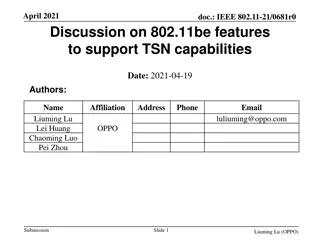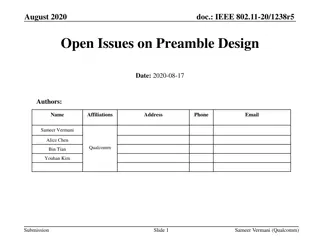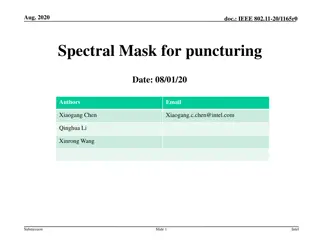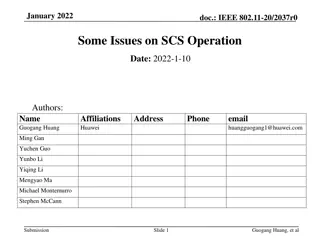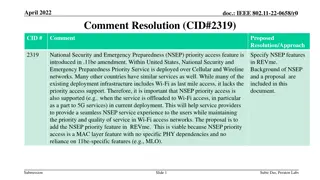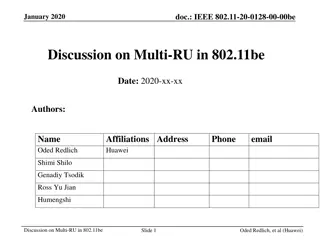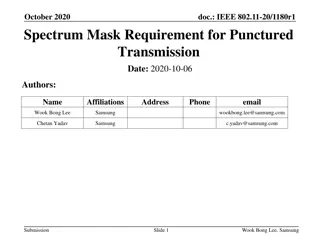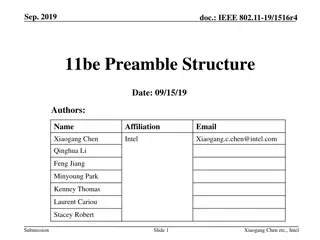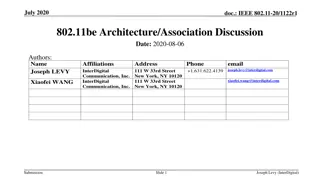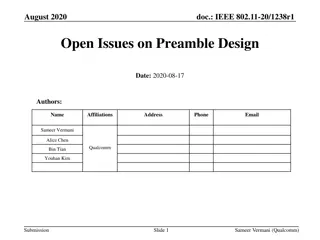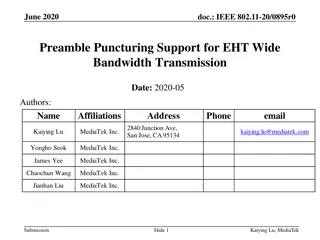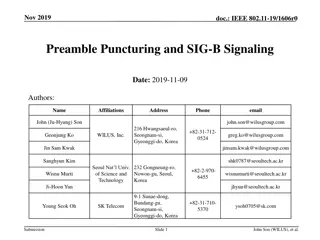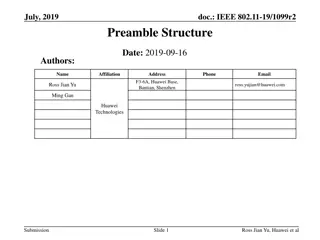Improved Preamble Puncturing in IEEE 802.11be Standard
The document discusses enhancements in preamble puncturing for the IEEE 802.11be standard, focusing on improving channel utilization in various network scenarios within a 160MHz bandwidth. It introduces improvements for multi-user and single-user PPDU scenarios to maximize available bandwidth and enhance transmission efficiency.
Download Presentation

Please find below an Image/Link to download the presentation.
The content on the website is provided AS IS for your information and personal use only. It may not be sold, licensed, or shared on other websites without obtaining consent from the author.If you encounter any issues during the download, it is possible that the publisher has removed the file from their server.
You are allowed to download the files provided on this website for personal or commercial use, subject to the condition that they are used lawfully. All files are the property of their respective owners.
The content on the website is provided AS IS for your information and personal use only. It may not be sold, licensed, or shared on other websites without obtaining consent from the author.
E N D
Presentation Transcript
Nov. 2019 doc.: IEEE 802.11-19/1190r02 Improved Preamble Puncturing in 802.11be Date: 2019-11-06 Authors: Name Oded Redlich Shimi Shilo Oren Hencinski Ohad Klausner Ross Jian Yu Yan Xin Affiliations Address Huawei Phone email Submission Slide 1 Oded Redlich (Huawei)
Nov. 2019 doc.: IEEE 802.11-19/1190r02 Background In the current 802.11ax standard there are 4 options (defined in HE-SIG-A for MU PPDU) for defining the preamble puncturing (SIG-B puncturing) when 80MHz or 160/80+80 MHz channel is defined These 4 options refer only to the segment in which the primary channel is located In the other segment (for BW>80MHz) puncturing is implicitly indicated in SIG- B (by using 242-tone RU empty ). Puncturing is not supported in SU-PPDU due to the absence of SIG-B; therefore SU-PPDU must be transmitted on the entire available contiguous BW In this presentation, we show some simulation results that demonstrate the improvement in channel utilization when applying an improved preamble puncturing in various network scenarios in 160MHz BW Submission Slide 2 Oded Redlich (Huawei)
Nov. 2019 doc.: IEEE 802.11-19/1190r02 Background Preamble Puncturing in 11ax Preamble Puncturing in 11ax 802.11ax preamble puncturing improves the channel utilization compared with previous 802.11 standards in which puncturing is not employed The channel utilization improvement is achieved by leveraging the characteristics of OFDMA in order to transmit over a wide BW with 20MHz resolution This way, 20MHz portions of the channel that are unavailable (e.g. occupied by other transmitters) may be skipped (punctured) Submission
Nov. 2019 doc.: IEEE 802.11-19/1190r02 Preamble Puncturing in 11be Nevertheless, the preamble puncturing may be further improved in 2 cases: 1. Improve support in MU-PPDU If the secondary 20MHz channel and the 4th 20MHz channel within the primary segment are simultaneously not available, content-channel 2 cannot be transmitted, therefore the BW reduces to 20MHz We suggest to overcome this by allowing all (or most of the) available BW when the above situation occurs Submission Slide 3
Nov. 2019 doc.: IEEE 802.11-19/1190r02 Preamble Puncturing in 11be Add support in SU-PPDU 2. SU-PPDU does not include SIG-B, nor does it include puncturing signaling in the BW field within SIG-A This means that SU-PPDU must be transmitted on the entire available contiguous BW We suggest to improve the channel utilization in SU-PPDU by adding puncturing capability to it as well. For example, use bitmap to indicate the punctured channels. Available channels Channels used in practice (available contiguous contiguous BW) Submission Slide 4 Oded Redlich (Huawei)
Nov. 2019 doc.: IEEE 802.11-19/1190r02 Improved Preamble Puncturing: Potential Gains In order to evaluate the potential gain when more flexible puncturing is supported, we ran a system level simulation We defined several simulation scenarios in which the BSS AP (which is the AP under test ) is located near several OBSS transmitters Assumptions: Each of OBSS APs serves 1-3 clients and may be any Legacy 802.11 (a/g, n, ac) The puncturing structure may change rapidly (hence is referred to as flexible ), even on any PPDU, especially in a dense environment where many STAs compete for the channel resources Submission Slide 6 Oded Redlich (Huawei)
Nov. 2019 doc.: IEEE 802.11-19/1190r02 Simulation Results: 20MHz Resolution Significant channel utilization gain Submission Slide 7 Oded Redlich (Huawei)
Nov. 2019 doc.: IEEE 802.11-19/1190r02 Simulation Results: 40MHz Resolution Channel utilization gain is still significant enough even when puncturing granularity is increased to 40MHzs. Submission
Nov. 2019 doc.: IEEE 802.11-19/1190r02 Conclusions We presented simulation results that show a significant gain in channel utilization when using a more effective channel puncturing than is used in 11ax For BW=160MHz, a dramatic gain was achieved for SU-PPDU while significant gain was achieved for the MU-PPDU case as well. It is reasonable to assume that higher gain may be achieved for BW>160MHz Further work should be done in order to define the necessary additional signaling to support the above puncturing Submission Slide 9 Oded Redlich (Huawei)
Nov. 2019 doc.: IEEE 802.11-19/1190r02 Straw Poll 1 Do you support to have preamble puncture mechanism for EHT MU PPDU? Yes No Abstain Submission Slide 10 Oded Redlich (Huawei)
Nov. 2019 doc.: IEEE 802.11-19/1190r02 Straw Poll 2 Do you support to have preamble puncture mechanism for EHT SU PPDU? Yes No Abstain Submission Slide 11 Oded Redlich (Huawei)






